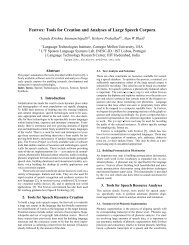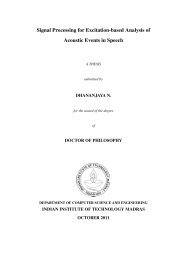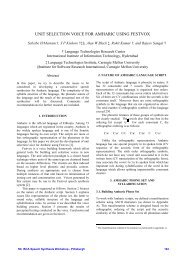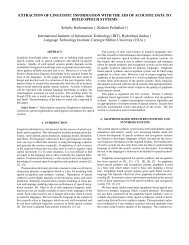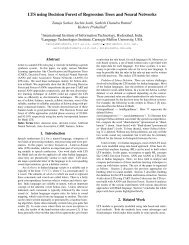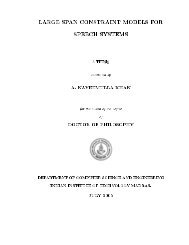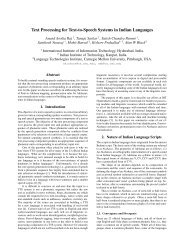word boundary- hypothesisation in hindi speech - Speech and ...
word boundary- hypothesisation in hindi speech - Speech and ...
word boundary- hypothesisation in hindi speech - Speech and ...
You also want an ePaper? Increase the reach of your titles
YUMPU automatically turns print PDFs into web optimized ePapers that Google loves.
2. Lexical match was performed at each syllable, which means that a <strong>word</strong> <strong>boundary</strong><br />
was assumed after every syllable.<br />
3. Lexical match was <strong>in</strong>itiated at the beg<strong>in</strong>n<strong>in</strong>g of the sentence <strong>and</strong> subsequently at the<br />
conclusion of each successful lexical match. This strategy was used <strong>in</strong> most <strong>speech</strong><br />
recognition systems [Cole <strong>and</strong> Jakimik 19801.<br />
4. Lexical match was <strong>in</strong>itiated at each strong syllable. This strategy was based on the<br />
Metrical. Segmentation Strategy(MSS) suggested for English [Cutler <strong>and</strong> Carter 19871.<br />
Thus, <strong>in</strong> this strategy, <strong>in</strong>formation regard<strong>in</strong>g <strong>word</strong> boundaries was used <strong>in</strong> match<strong>in</strong>g.<br />
The above four lexical match strategies were compared on three types of <strong>in</strong>put<br />
representation of <strong>in</strong>creas<strong>in</strong>g complexity, namely, (a) A sentence represented as a<br />
sequence of phonemes, (b) a sentence transcribed such that the strong syllables were<br />
transcribed exactly whereas the weak syllables were transcribed <strong>in</strong>to their broadclass<br />
categories, <strong>and</strong> (c) a sentence transcribed such that the strong syllables were<br />
transcribed <strong>in</strong>to their midclass categories <strong>and</strong> the weak syllables <strong>in</strong>to their broadclass<br />
categories. Thus the above three types of <strong>in</strong>puts were of <strong>in</strong>creas<strong>in</strong>g complexity. The<br />
results of the study were as follows:<br />
1. For <strong>in</strong>put type (a), Strategies 1 <strong>and</strong> 2 produced more match<strong>in</strong>g <strong>word</strong> sequences than<br />
strategies 3 <strong>and</strong> 4, as expected.<br />
2. For <strong>in</strong>put types (b) <strong>and</strong> (c), strategy 1 aga<strong>in</strong> produced the highest number of<br />
match<strong>in</strong>g <strong>word</strong> sequences. But unlike the earlier case, strategy 2 performed better than<br />
strategy 3 <strong>in</strong> that it produced less number of match<strong>in</strong>g <strong>word</strong> sequences. Strategy 4<br />
performed best by produc<strong>in</strong>g the least number of match<strong>in</strong>g <strong>word</strong> sequences.<br />
The above results established that knowledge of the <strong>word</strong> boundaries (even if it<br />
is only partial as <strong>in</strong> strategy 2) can improve the performance of the lexical match,<br />
especially when the <strong>in</strong>put is only partially known (midclass or broadclass str<strong>in</strong>gs). Of





